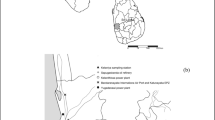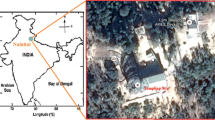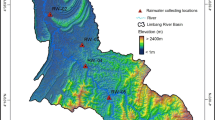Abstract
The composition of atmospheric deposition is a measure of air quality, an important aspect of the health of the ecosystem. Consequently, continuous monitoring of atmospheric deposition is crucial to obtain remedial measures to avoid undesirable aspects that would affect living things. In this context, the objective of this study was to determine the rainwater quality at selected locations in Kandy and Peradeniya area of Sri Lanka, namely, Kandy, Polgolla, and University of Peradeniya (UOP), and to identify possible correlations between quality parameters through statistical means. Forty (40) rainwater samples from the UOP site and seven (07) samples each from the Kandy and Polgolla sites were collected from 18 May 2020 to 28 April 2021. The volume-weighted average (VWA) pH values of UOP, Kandy, and Polgolla sites were determined to be 7.44, 7.19, and 7.19, respectively, and moreover, acid rain (pH < 5.6) occurrences were not detected during the sampling period. The VWA values of rainfall, conductivity, salinity, TDS, and hardness at the UOP site were 40.12 mm, 51.93 μS cm−1, 0.0300 ppt, 26.59 mg L−1, and 13.55 mg L−1, respectively. The corresponding values of the Kandy site were 16.52 mm, 64.04 μS cm−1, 0.0361 ppt, 30.80 mg L−1, and 19.49 mg L−1, respectively; and those of the Polgolla site were 33.10 mm, 53.90 μS cm−1, 0.0310 ppt, 25.76 mg L−1, and 19.31 mg L−1, respectively. The VWA values of conductivity, salinity, and TDS were the highest at the Kandy site. Further, the VWA values of hardness at Kandy and Polgolla sites were approximately equal, probably due to the spring of Ca2+ and Mg2+ particulates from the dolomite quarry located in Digana area. The most prominent anion was identified as Cl− in bulk deposition at all three sites, while NO3− showed the lowest concentration of all sites. Moreover, very strong significant positive correlations were identified between conductivity-TDS, conductivity-salinity, conductivity-hardness, TDS-hardness, TDS-salinity, salinity-hardness, SO42−-Cl−, and NO3−-Cl− according to the relevant Pearson correlation coefficients. It is thus concluded that the pollutants come from the same sources, either natural or anthropogenic.
















Similar content being viewed by others

Data availability
The data generated during and/or analyzed during the current study are available from the corresponding author, N. Priyantha, upon request.
References
Abdemanafi, D., Meshkatee, A., & Hejam, S. (2021). The study of pH, total dissolved solids (TDS), electrical conductivity (EC), total alkalinity and total hardness of rain water over Tehran city. Journal of Climate Research, 1399(44), 1–14.
Abeyratne, V. D. K., & Ileperuma, O. A. (2006). Air pollution monitoring in the city of Kandy: Possible transboundary effects. Journal of the National Science Foundation of Sri Lanka, 34(3), 137. https://doi.org/10.4038/jnsfsr.v34i3.3644
Adachi, K. (2006). Characterization of atmospheric dry deposition particulates in Kobe, Japan. Chemosphere, 64(8), 1311–1317. https://doi.org/10.1016/j.chemosphere.2005.12.055
Adhikari, S., Zhang, F., Adhikari, N. P., Zeng, C., Pant, R. R., Ram, K., Liu, Y., Ahmed, N., Xu, J., Tripathee, L., Zhang, Q., Bhuiyan, M. A., & Ahsan, M. A. (2021). Atmospheric wet deposition of major ionic constituents and inorganic nitrogen in Bangladesh: Implications for spatiotemporal variation and source apportionment. Atmospheric Research, 250, 105414. https://doi.org/10.1016/j.atmosres.2020.105414
Alastuey, A., Querol, X., Chares, A., Ruiz, C. R., & Carratula, L.-S. A. (1999). Bulk deposition in a rural area located around a large coal-fired power station, Northeast Spain. Environmental Pollution, 106(3), 359–367. Available at. https://doi.org/10.1016/s0269-7491(99)00103-7
Al-Momani, I. F., Monani, K. A., Jaradat, Q. M., Massadeh, A. M., Yousef, Y. A., & Alomary, A. A. (2007). Atmospheric deposition of major and trace elements in Amman, Jordan. Environmental Monitoring and Assessment, 136(1-3), 209–218. https://doi.org/10.1007/s10661-007-9676-4
Anderson, H. R. (1999). Health effects of air pollution episodes. Air Pollution and Health, 461–482. https://doi.org/10.1016/b978-012352335-8/50096-x
Bayraktar, H., & Turalioglu, F. S. (2005). Composition of wet and bulk deposition in Erzurum, Turkey. Chemosphere, 59(11), 1537–1546. https://doi.org/10.1016/j.chemosphere.2005.02.013
Bian, B., Cheng, X.-J., & Li, L. (2011). Investigation of urban water quality using simulated rainfall in a medium size city of China. Environmental Monitoring and Assessment, 183(1–4), 217–229. https://doi.org/10.1007/s10661-011-1916-y
Bisht, D. S., Srivastava, A. K., Joshi, H., Ram, K., Singh, N., Naja, M., Srivastava, M. K., & Tiwari, S. (2016). Chemical characterization of rainwater at a high-altitude site “Nainital” in the Central Himalayas, India. Environmental Science and Pollution Research, 24(4), 3959–3969. https://doi.org/10.1007/s11356-016-8093-z
Bisht, D. S., Srivastava, A. K., Singh, V., Tiwari, S., Gautam, A. S., Gautam, S., Santosh, M., & Kumar, S. (2022). High-altitude air pollutants monitored from rainwater chemistry in the Central Himalaya. Water, Air, & Soil Pollution, 233(9). https://doi.org/10.1007/s11270-022-05855-8
Brezonik, P. L., & Stadelmann, T. H. (2002). Analysis and predictive models of stormwater runoff volumes, loads, and pollutant concentrations from watersheds in the Twin Cities metropolitan area, Minnesota, USA. Water Research, 36(7), 1743–1757. https://doi.org/10.1016/s0043-1354(01)00375-x
Buffleben, M. S., Zayeed, K., Kimbrough, D., Stenstrom, M. K., & Suffet, I. H. (2002). Evaluation of urban non-point source runoff of hazardous metals entering Santa Monica Bay, California. Water Science and Technology, 45(9), 263–268. https://doi.org/10.2166/wst.2002.0254
Chantara, S., & Chunsuk, N. (2008). Comparison of wet-only and bulk deposition at Chiang Mai (Thailand) based on rainwater chemical composition. Atmospheric Environment, 42(22), 5511–5518. https://doi.org/10.1016/j.atmosenv.2008.03.022
Charlson, R. J., & Rodhe, H. (1982). Factors controlling the acidity of natural rainwater. Nature, 295(5851), 683–685. https://doi.org/10.1038/295683a0
Chathuranga, R. A. J., Liyandeniya, A. B., Dharmapriya, T. N., & Priyantha, N. (2020). Risk assessment and source apportionment of wet bulk deposition in three typical sites of Gampaha District, Sri Lanka. SN Applied Sciences, 2(8). https://doi.org/10.1007/s42452-020-3007-6
Dharaka, B. D. P., & Priyantha, N. (2023). Atmospheric quality through analysis of dry and wet deposition at selected locations in Kandy and Gampaha Districts of Sri Lanka. Air Quality, Atmosphere and Health. https://doi.org/10.1007/s11869-023-01431-z
Dharmapriya, T.N., Rathnayake, I.M.S.K., Madushani, L.S., Deeyamulla, M.P., Priyantha, H.M.D.N. (2023) “Comparison of ionic concentrations (Na+, Ca2+, Mg2+, NH4+, Cl-, SO42-, NO3-) and water quality parameters of bulk depositions among three sites in Kandy area, Sri Lanka.” https://doi.org/10.21203/rs.3.rs-2731158/v1.
Farreny, R., Morales-Pinzón, T., Guisasola, A., Tayà, C., Rieradevall, J., & Gabarrell, X. (2011). Roof selection for rainwater harvesting: Quantity and quality assessments in Spain. Water Research, 45(10), 3245–3254. https://doi.org/10.1016/j.watres.2011.03.036
Goldsmith, J. R. (1968). Effects of air pollution on human health. Air Pollution and its Effects, 547–615. https://doi.org/10.1016/b978-0-12-666551-2.50021-2
Gunawardana, C., Goonetilleke, A., Egodawatta, P., Dawes, L., & Kokot, S. (2012). Source characterisation of road dust based on chemical and mineralogical composition. Chemosphere, 87(2), 163–170. https://doi.org/10.1016/j.chemosphere.2011.12.012
Gunawardena, J., Egodawatta, P., Ayoko, G. A., & Goonetilleke, A. (2012). Role of traffic in atmospheric accumulation of heavy metals and polycyclic aromatic hydrocarbons. Atmospheric Environment, 54, 502–510. https://doi.org/10.1016/j.atmosenv.2012.02.058
Gunawardena, J., Egodawatta, P., Ayoko, G. A., & Goonetilleke, A. (2013). atmospheric deposition as a source of heavy metals in urban stormwater. Atmospheric Environment, 68, 235–242. Available at. https://doi.org/10.1016/j.atmosenv.2012.11.062
Ileperuma, O. A. (2000). Environmental pollution in Sri Lanka: A review. Journal of the National Science Foundation of Sri Lanka, 28(4), 301. https://doi.org/10.4038/jnsfsr.v28i4.2644
Ileperuma, O. A. (2020). Review of air pollution studies in Sri Lanka. Ceylon Journal of Science, 49(3), 225. https://doi.org/10.4038/cjs.v49i3.7773
Jayawardene, H. K. W. I., Sonnadara, D. U. J., & Jayewardene, D. R. (2005). Trends of rainfall in Sri Lanka over the last century. Sri Lankan Journal of Physics, 6, 7. https://doi.org/10.4038/sljp.v6i0.197
Krämer, M., Schüle, M., & Schütz, L. (1996). A method to determine rainwater solutes from pH and conductivity measurements. Atmospheric Environment, 30(19), 3291–3300. https://doi.org/10.1016/1352-2310(96)00070-2
Liljestrand, H. M. (1985). Average rainwater pH, concepts of atmospheric acidity, and buffering in open systems. Atmospheric Environment (1967), 19(3), 487–499. https://doi.org/10.1016/0004-6981(85)90169-6
Liyandeniya, A. B., Deeyamulla, M. P., Abeysundara, S. P., & Priyantha, N. (2020a). Chemical characteristics of wet precipitation at Peradeniya in Sri Lanka. Environmental Monitoring and Assessment, 193(1). https://doi.org/10.1007/s10661-020-08772-7
Liyandeniya, A. B., Deeyamulla, M. P., & Priyantha, N. (2020b). Source apportionment of rainwater chemical composition in wet precipitation at Kelaniya in Sri Lanka. Air Quality, Atmosphere and Health, 13(12), 1497–1504. https://doi.org/10.1007/s11869-020-00903-w
Liyandeniya, A. B., Deeyamulla, M. P., & Priyantha, N. (2020c). Atmospheric chemical composition of bulk deposition at two geographically distinct locations in Sri Lanka. Environmental Monitoring and Assessment, 192(7) Available at. https://doi.org/10.1007/s10661-020-08412-0
Madhushani, L. S., Dharmapriya, T. N., Dharaka, B. D. P., Deeyamulla, M. P., & Priyantha, N. (2023). Chemical composition of rainwater at three sites in Kandy/Peradeniya, Sri Lanka, and its effect on air pollution. Energy Nexus, 12, 100243. https://doi.org/10.1016/j.nexus.2023.100243
Majumder, N., Dutta, M., Chatterjee, A., Bakshi, S., Sanyal, P., Paul, M., Gupta, V. K., Acharya, A., & Mukhopadhayay, S. K. (2022). Ionic composition, source identification of rainwater, and its contribution to nutrient deposition in monsoon, over Sundarban mangrove forest. Journal of Atmospheric Chemistry, 80(2), 121–136. https://doi.org/10.1007/s10874-022-09441-4
Migliavacca, D., Teixerira, E. C., Wiegand, F., Machado, A. C. M., & Sanchrz, J. (2005). Atmospheric precipitation and chemical composition of an urban site, Guaíba hydrographic basin, Brazil. Atmospheric Environment, 39(10), 1829–1844. https://doi.org/10.1016/j.atmosenv.2004.12.005
Nandasena, S., Wickremasinghe, A. R., & Sathiakumar, N. (2012). Air pollution and public health in developing countries: Is Sri Lanka different? Journal of the College of Community Physicians of Sri Lanka, 17(1), 15. Available at. https://doi.org/10.4038/jccpsl.v17i1.4932
Nandasena, Y. L., Wickremasinghe, A. R., & Sathiakumar, N. (2010). Air pollution and health in Sri Lanka: A review of epidemiologic studies. BMC Public Health, 10(1). https://doi.org/10.1186/1471-2458-10-300
Pant, R. R., Bishwakarma, K., Rehman Qaiser, F. U., Pathak, L., Jayaswal, G., Sapkota, B., Pal, K. B., Thapa, L. B., Koirala, M., Rijal, K., & Maskey, R. (2021). Imprints of COVID-19 lockdown on the surface water quality of Bagmati River basin, Nepal. Journal of Environmental Management, 289, 112522. https://doi.org/10.1016/j.jenvman.2021.112522
Perera, G. B. S., Emmanuel, R., Nandasena, Y. L. S., & Premasiri, H. D. S. (2010). Exposure to aerosol pollution and reported respiratory symptoms among segments of urban and rural populations in Sri Lanka. Built-Environment Sri Lanka, 7(2), 31. https://doi.org/10.4038/besl.v7i2.1941
Rebello, L. R. B., Siepman, T., & Drexler, S. (2020). Correlations between TDS and electrical conductivity for high-salinity formation brines characteristic of South Atlantic pre-salt basins. Water SA, 46(4 October) Available at:. https://doi.org/10.17159/wsa/2020.v46.i4.9073
Roy, A., Chatterjee, A., Tiwari, S., Sarkar, C., Das, S. K., Ghosh, S. K., & Raha, S. (2016). Precipitation chemistry over urban, rural and high altitude Himalayan stations in Eastern India. Atmospheric Research, 181, 44–53. https://doi.org/10.1016/j.atmosres.2016.06.005
Rusydi, A. F. (2018). Correlation between conductivity and total dissolved solid in various type of water: A review. IOP Conference Series: Earth and Environmental Science, 118, 012019. Available at. https://doi.org/10.1088/1755-1315/118/1/012019
Sakihama, H., Ishiki, M., & Tokuyama, A. (2008). Chemical characteristics of precipitation in Okinawa Island, Japan. Atmospheric Environment, 42(10), 2320–2335. https://doi.org/10.1016/j.atmosenv.2007.12.02
Samaradiwakara, D. S., & Pitawala, H. M. (2021). Extent of air pollution in Kandy area, Sri Lanka: Morphological, mineralogical and chemical characterization of dust. Ceylon Journal of Science, 50(4), 475. https://doi.org/10.4038/cjs.v50i4.7946
Sembhi, H., Wooster, M., Zhang, T., Sharma, S., Singh, N., Agarwal, S., Boesch, H., Gupta, S., Misra, A., Tripathi, S. N., Mor, S., & Khaiwal, R. (2020). Post-monsoon air quality degradation across northern India: Assessing the impact of policy-related shifts in timing and amount of crop residue burnt. Environmental Research Letters, 15(10), 104067. https://doi.org/10.1088/1748-9326/aba714
Staelens, J., Schrijver, A. D., Avermaet, P. V., Genouw, G., & Verhoest, N. (2005). A comparison of bulk and wet-only deposition at two adjacent sites in Melle (Belgium). Atmospheric Environment, 39(1), 7–15. https://doi.org/10.1016/j.atmosenv.2004.09.055
Tiwari, S., Chate, D. M., Bisht, D. S., Srivastava, M. K., & Padmanabhamurty, B. (2012). Rainwater chemistry in the North Western Himalayan region, India. Atmospheric Research, 104–105, 128–138. https://doi.org/10.1016/j.atmosres.2011.09.006
Tiwari, S., Hopke, P. K., Thimmaiah, D., Dumka, U. C., Srivastava, A. K., Bisht, D. S., Rao, P. S. P., Chate, D. M., Srivastava, M. K., & Tripathi, S. N. (2016). Nature and sources of ionic species in precipitation across the Indo-Gangetic Plains, India. Aerosol and Air Quality Research, 16(4), 943–957. https://doi.org/10.4209/aaqr.2015.06.0423
Ullah, M., Islam, M. S., Akter, F., Shohel, M., Rokonujjaman, M., & Salam, A. (2022). Chemical composition and source apportionment of rainwater over Bangladesh during the Monsoon. International journal of Environmental Science and Technology, 20(8), 8445–8456. https://doi.org/10.1007/s13762-022-04507-y
Weerasundara, L., et al. (2017). Microorganisms and heavy metals associated with atmospheric deposition in a congested urban environment of a developing country: Sri Lanka. Science of the Total Environment, 584-585, 803–812. Available at. https://doi.org/10.1016/j.scitotenv.2017.01.121
Xu, Z., Wu, Y., Liu, W. J., Liang, C. S., Ji, J., Zhao, T., & Zhang, X. (2015). Chemical composition of rainwater and the acid neutralizing effect at Beijing and Chizhou City, China. Atmospheric Research, 164-165, 278–285. https://doi.org/10.1016/j.atmosres.2015.05.009
Yatigammana, S., Fernando, G. and Liyanage, M. (2022) ‘A study on local air pollution due to transport emissions in Kandy City’, Proceedings of the SLIIT International Conference on Engineering and Technology [Preprint]. https://doi.org/10.54389/buot2540.
Zhang, Q., Wang, X., Hou, P., Wan, W., Li, R., Ren, Y., & Ouyang, Z. (2014). Quality and seasonal variation of rainwater harvested from concrete, asphalt, ceramic tile and green roofs in Chongqing, China. Journal of Environmental Management, 132, 178–187. https://doi.org/10.1016/j.jenvman.2013.11.009
Zhu, W., Bian, B., & Li, L. (2007). Heavy metal contamination of road-deposited sediments in a medium size city of China. Environmental Monitoring and Assessment, 147(1–3), 171–181. https://doi.org/10.1007/s10661-007-0108-2
Acknowledgements
The authors are grateful to the Provincial Department of Education of Central Province and Mahaweli Authority of Sri Lanka, for collaborations provided for sampling. The authors also thank the Postgraduate Institute of Science, University of Peradeniya, Sri Lanka, for providing facilities for chemical analysis.
Author information
Authors and Affiliations
Contributions
All authors contributed to the conception and design of the study in different aspects. Initial planning of the study, supervision, and final corrections were performed by N.P. and M.P.D. Sample collection, determination of rainwater quality parameters, and analysis were performed by H.L.S.S.W. Data interpretation, compiling of the initial draft of the manuscript, and finalizing were done by B.D.P.D. All authors have read, commented, and approved the final manuscript of the study.
Corresponding author
Ethics declarations
Ethical approval
All authors have read, understood, and have complied as applicable with the statement on “Ethical Responsibilities of Authors” as found in the Instructions for Authors. This research did not involve any human or animal subjects or biological material or their data.
Consent to participate
This research did not involve any human subjects.
Consent for publication
This research did not involve any human subjects.
Competing interests
The authors declare no competing interests.
Additional information
Publisher’s note
Springer Nature remains neutral with regard to jurisdictional claims in published maps and institutional affiliations.
Rights and permissions
Springer Nature or its licensor (e.g. a society or other partner) holds exclusive rights to this article under a publishing agreement with the author(s) or other rightsholder(s); author self-archiving of the accepted manuscript version of this article is solely governed by the terms of such publishing agreement and applicable law.
About this article
Cite this article
Wijewantha, H.L.S.S., Dharaka, B.D.P., Deeyamulla, M.P. et al. Monitoring of rainwater quality in Kandy and Peradeniya, Sri Lanka. Environ Monit Assess 196, 218 (2024). https://doi.org/10.1007/s10661-024-12352-4
Received:
Accepted:
Published:
DOI: https://doi.org/10.1007/s10661-024-12352-4



